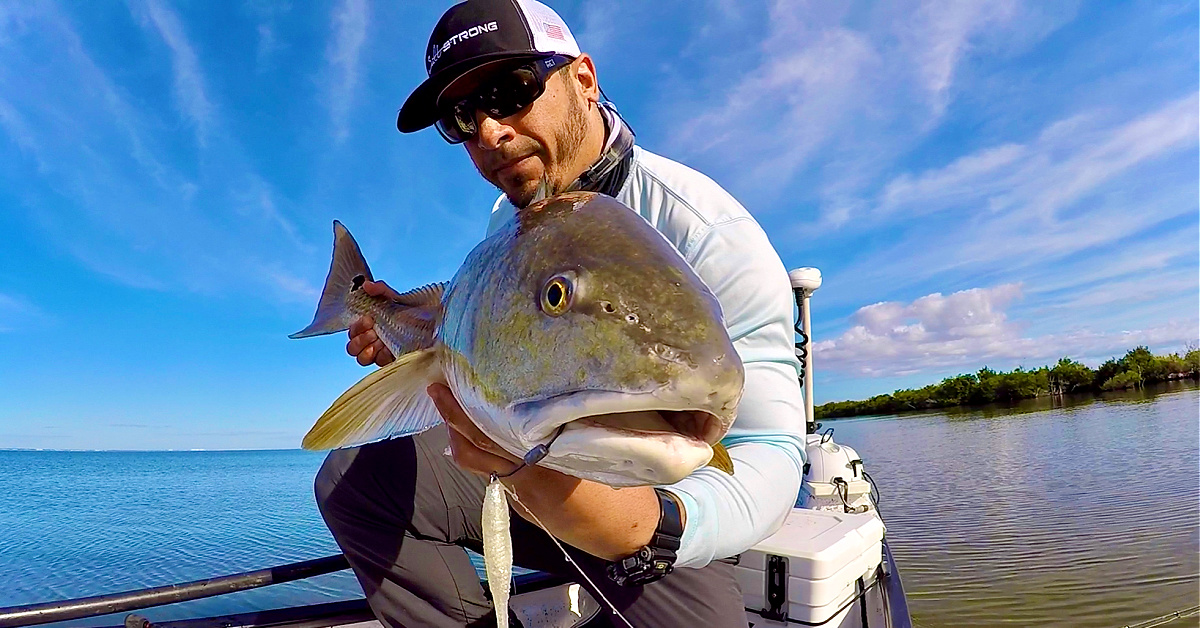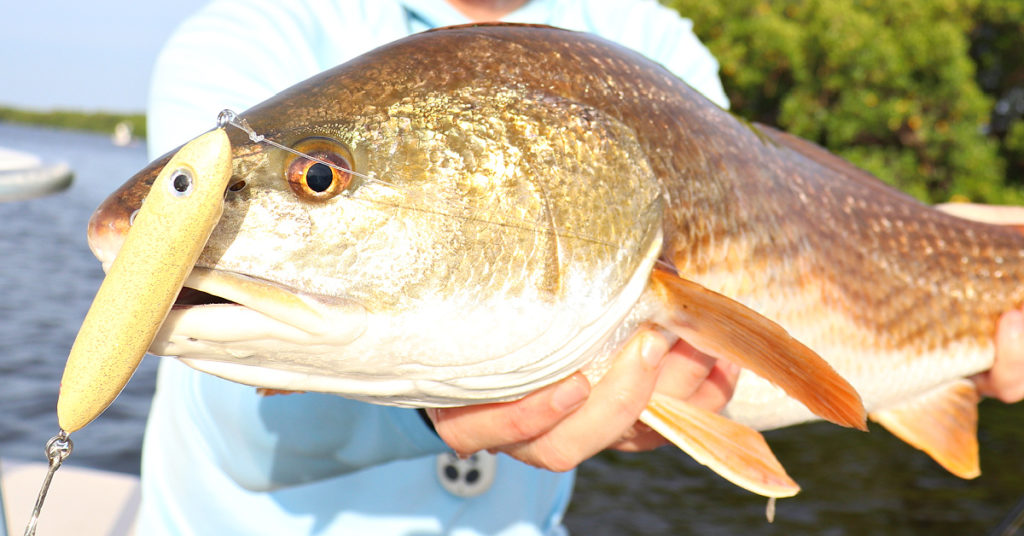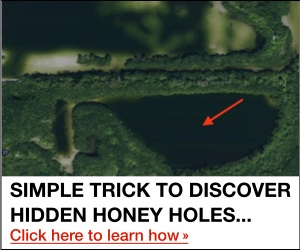Making Sense Of New Redfish Regulations In Florida (Plus Cobia Carcass Payday)
- By: Joseph Simonds
- on

Have you heard of or seen the potential NEW redfish regulations in Florida?
The Florida Fish & Wildlife Conservation Commission recently shared their proposed changes to current Florida redfish regulations.
In this episode, we’re analyzing and diving into each and every page of the document and what it could mean for the future of redfish fishing in Florida.
The new regulations discussed have NOT gone into effect as of today.
Keep scrolling to find out what it could mean for your local fishery.
We’ve got you covered below!!!
You can watch the video version of this podcast below (which I highly recommend), listen to the audio version by clicking the play button underneath it, or listen to it on iTunes, Stitcher, or Spotify.
P.S. Don’t forget to subscribe on iTunes, Stitcher, or Spotify and leave us a review!

New Redfish Regulations In Florida [PODCAST]
Note: Don’t forget to subscribe to the Salt Strong podcast on iTunes, Stitcher, or Spotify and leave us a review!

Related Podcasts:
- WE’VE GOT 30,000 REDFISH. WHERE SHOULD WE PUT THEM?
- SCIENCE-BASED STRATEGIES TO CATCH REDFISH (WITH CAPT. CALEB MCCUMBER)
Here is a timestamped version of this episode:
- 1:30 – Making sense of POTENTIAL New Redfish Regulations in Florida
- 3:09 – Quick background of the current harvest regulations
- 4:28 – FWC Decisions & Meetings
- 5:16 – Separation of zones in Florida
- 7:08 – Captain/Crew Bag Limit
- 9:35 – Redfish Sportfishing
- 10:48 – Bass Fishing Tournament Lessons Learned
- 12:35 – Panhandle Region
- 15:35 – Big Bend Region
- 17:34 – Tampa Bay Region
- 24:34 – Sarasota Region
- 27:47 – Charlotte Harbor Region
- 30:09 – Sampling & Research
- 31:20 – Southwest Region
- 36:41 – Indian River Region
- 39:29 – Northeast Region
- 42:58 – Cobia Carcass Reward
- 46:29 – What topics and guests do you want to hear on the podcast?
- 47:07 – Know the regulations in your area!!!
[optin-monster slug=”wcrcrc7d6ih5k29wooi4″ followrules=”true”]
New Redfish Regulations In Florida [VIDEO]

Conclusion

All in all, it is up to us as anglers to speak out and let our voices be heard to protect our local fisheries for the future generations.
Always have an active license and make sure you know the harvesting regulations in your area!!!
Do your part in sustaining our fisheries for the coming generations of anglers.
Do you have any more questions about the potential new redfish regulations in Florida?
Let us know your thoughts, opinions, or any other comments down below!!
And if you know someone who wants to learn more about the potential new redfish regulations in Florida, please TAG or SHARE this with them!
P.S. Want access to our best fishing spots and tips, plus discounts to our online tackle store? Click here to join us in the Insider Club!
Related Articles:
Related categories:
STOP WASTING TIME ON THE WATER!
Do what the “SMART ANGLERS” are doing and join the Insider Club.
Here’s what you’ll receive today when you join:
- Weekly fishing reports and TRENDS revealing exactly where you should fish every trip
- Weekly “spot dissection” videos that walk you through all the best spots in your area
- Exclusive fishing tips from the PROS you can’t find anywhere else
- Everything you need to start catching fish more consistently (regardless if you fish out of a boat, kayak, or land).













I concur with some of the above posts. Other fish predation seems like a higher impact than human intervention, making the case for increased regulation less of an argument. I know of some flats around in the Indian River that used to possess a high population of redfish. Many now are infested with Jacks, which are notoriously voracious and unfinicky eaters. A better solution seems to be a program focusing on Jack reduction. A light dusting of Everglades on both sides can make for a tasty Jack meal, a little like Mahi. I was also thinking of maybe a tax incentive for restaurants to start serving it. Realistically, one Jack might consume hundreds of hatchlings a year perhaps, though I’m not sure. Another point: the metrics of this new reg seem out of whack with hunting. For example, you can take 5 deer a year and 12 rabbits daily in the state, but you are not allowed to take a single Redfish in the Indian River Lagoon. I have not seen the actual population data of all these species, but I imagine there are more Redfish in the state than deer. Or am I wrong?
Living and fishing in Flagler County as well as Volusia for the past 15 years, I and others have noticed a distinct reduction in redfish catch rates since the two fish per person rule went into effect. Several factors have contributed to this downturn. First, being the obvious that doubling landings has impacted the biomass and recruitment. We typically saw multiple large schools of upper to over slot fish in the winter in the Highbridge marsh, Tomoka Basin and in the bights along the intracoastal in Flagler County, I.E. Stomach Lake, Big and Little Silver Lakes as well as Long and Pelicer Creeks discharges into the Intracoastal. Moreover, places that consistently yielded catches of under slot redfish no longer have the numbers they once had. Second, a noticeable degradation of water quality. Water quality especially in southern Flagler and northern Volusia has created an increase in a strange algae growing in the Highbridge Marsh during the warmer months. Places with this algae which consistently held fish in the summer no longer do. Additionally, increased boat traffic in the intracoastal increased turbidity and we are not seeing the numbers of redfish we typically saw 10 years ago crawling the banks in the early morning and late afternoons throughout the summer into the fall. Furthermore, oyster growth is almost non-existent as well as live oysters south of Long Creel. Third, which is not necessarily a bad thing is the increase in our snook population. Without checking stomach contents to verify if this increase is effecting our redfish and trout population we can only speculate. However, since the 2010 freeze the snook biomass and recruitment has increased exponentially while catch rates of redfish and trout have decreased. Which leads me to the a recommendation regarding this increase. I and others I’ve discussed this with agree the snook slot for north Florida waters of Flagler and St. Johns County should have a slot specific to the population of fish we have. We believe a slot from 24″-28″ with one fish up to 32″ would be appropriate for this area. Yes there are plenty of over slot breeding fish in this area but, there is a tremendous amount of snook in the 24″-28″ range as well as juvenile fish from fingerling size up to the aforementioned slot recommendation. We consistently catch yearling size and under when cast netting for bait as well as on fly and small live baits and artificial baits. Perhaps making this fish more accessible would also reduce pressure on redfish from anglers as well as reduce predation and allow better recruitment and increase the biomass of redfish and trout.
Based on these issues, I would propose the regulations be reduced to one redfish again, also put a moratorium on trout retention while conducting a stock assessment and lastly adjust the snook slot as proposed.
Since you didn’t know what ‘escapement’ was (~12 minute mark) —
From the document you’re referencing in this podcast:
<< Red drum stocks have rebounded and are currently exceeding the FWC’s management goal of 40% escapement in most parts of Florida. Escapement is the proportion of fish that survive through age four relative to the fish that would have survived if there was no fishery. >>
ie, a measure of survivability to promulgating the specie as a relationship to a theoretical non-fishing environment. So assuming 100% survivability (were there NO fishing), they target a 40% of that (4 y/o’s)…meaning a 60% acceptable loss (of 4 y/o’s & under) due to our fishing’s effects.
There’s probably an easier way of saying it, but my explanation is easier to understand for those who like things more-confusing. 😉
I suspect the “science” underlying these calculations are squishy at best, or random guesses at worst. If there was no fishing in the fishery, how many survive to 4 yrs. of age as the mortality rate is extremely high relative to the number of hatchlings. My guess is somewhere above 90% of hatchlings don’t survive to age 4 due to predation and other natural causes. And how do they capture serious degradation to water quality and seagrass, and the loss of fish which seems to be assumed as caught and killed by fisherman.
Yeah, hard to be precise/accurate with this kind of stuff, I’d agree. But I suspect decades of trends on their end, postulations/evals, standard dev’s and all…it’s probably closer than just taking a wild-a**ed guess at it. LOL So your “guess” of 90% above…any citations or calc’s on that figure (for redfish) to back it up? [just looking for enlightenment, because I don’t know it all]. As to differentiating apportionment of habitat effects vs harvest effects…they probably have something for that, too. Since it’s imprecise, I’m sure naysayers on the outside will be able to find small faults or pose doubts (as you are assuming here). I think it’s great that they solicit opinions on this from the stakeholders. That in itself is an admission of the fuzziness of their task, but as we all know, it’s not JUST about escapement and the probable science. It’s also big picture. I more worry about what the blended [and likely righteous] recommendation becomes when it finally gets processed thru the mgt/board level.
Back to my orig point, tho….the SS presenters were fumbling with the term ‘escapement’…I just wanted to provide the FWC’s definition for the word to help them and more-importantly, the viewers out.
Thanks for your opinion, and TIA for your providing details on 90% redfish mortality figure.
Lemme peruse those links before I respond in full, I might find the keys to life there. [I suspect I may have perused them in past, but mind can be mush, just like some of the science in this subject. Still, their numbers are better than mine…which is zero.]
Natural mortality of young – yep, high, I know that (millions of eggs, etc.). You used ‘guess’, so I asked you to cite, since we’re debating ‘data substantiation’.
Tight lines back at ya.
1) Took a look at those links (not what I have viewed in past) – they were useless to the discussion. First one left more questions than answers. Not much ‘common sense’ to be had there: as they’re releasing fry (1.5″) to the ocean [?????], capital vs income…fatty acids or not (and when?), makes them more survivable? So stronger, more expensive to feed fry, vs a weaker fry? They’re still fry (or fingerlings, as they call em). Survivability?? LOL Although it IS expensive to do what they’ve been doing, they say. Don’t see how that greatly helps the fishery, and they admit as much – both pieces – use of the word ‘might’ as far as accomplishing things. Did I miss something?? ‘Mushy’, I read. Decade-plus old, too. btw, The state instituted an extreme closure, to start the process, which they say was necessary to jumpstart the recovery (ie, it helped!). Ahhh…the nod to ‘limiting harvests’…. Sound familiar?
2) You’re welcomed to think what you want about the study group. So far, I haven’t heard any solid back-up to your notions/feelings. I am reasonably ok with the ‘scientists’, as they’ve likely followed scientific protocols and statistical analysis. “Gotta have ‘some’ faith, man”. Accuracy, who the heck knows? But better than my numbers, and yours, too. I’ll stand on my earlier comments. And that would also include the doubts I have once this all gets into mgt’s/politicians’ sphere of influence…then the sausage-making begins. [vomit]
3) Yep, I’ve doubts about the geographical limits of the likely closure…because I don’t think they’ve done ‘science’ on that part. ie, They’re gravely misjudging human nature (I may be wrong, but I think their job is the study of fish, not necessarily human behavior, at least in the science portion of the dept. L/E a different story, but I dunno L/Es pecking order and input in this formulative process.). Hence, my concern that you referenced (adjoining areas will see more pressure). Will be interesting to see how that gets managed at Callalisa ramp. LOL
4) So, yeah, I made mention of that notion to FWC…twice, in fact! LOL I exercised my ‘democracy’. btw, You don’t need to presume to lecture me on that item. OK? 🙂
5) With all your complaints/doubts of the Fla system you’ve elucidated here…have YOU run this thru FWC, your LOCAL and STATE POLS, ETC.? ‘Democracy’, right? Seems to me that’s where you should be directing this. LOL
6) Bigger picture, bigger problem: water/habitat. Agreed. And I think I’ve stated as much in past here. Don’t think I said anything to contrary. So how long has the IRL System been that way, with little-to-nothing getting done (besides lip service)? Year? Few? Decade? More? [you’re preaching to the choir on this one] So that’s why…
7) I tend to focus on something each of us can do today…even yesterday. ‘More judicious harvesting’. It’s a personal choice. SS has had podcasts touching on this, besides this one. And – despite your contentions – there is nevertheless a relationship between level of harvesting and the fishery stocks. Otherwise, FWC wouldn’t be recommending the restrictions they have over the years over several species. Even TX said so (my #1 above, your 2nd link).
Finally, Rob,
8) I dialed up “FWC’s definition of ‘escapement’,” that’s all. Somehow, we went 1 thru 7 above. Wow. Thanks for showing me what you’re made of. [thumbs-up]
Tight lines, and be happy! Go fishing.
As I tend to travel along the east coast throughout the year, including Florida, here’s hoping you add fishing regulations to your app.